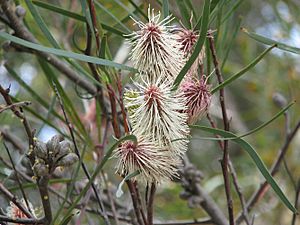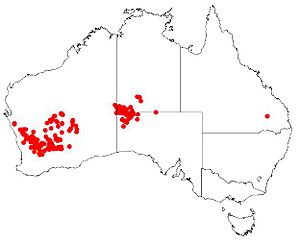Watjula facts for kids
Quick facts for kids Watjula |
|
|---|---|
 |
|
| Hakea minyma in Maranoa Gardens | |
| Scientific classification | |
| Genus: |
Hakea
|
| Species: |
minyma
|
 |
|
| Occurrence data from AVH | |
| Synonyms | |
|
Hakea glabella R.Br. |
|
The watjula plant, also known as Hakea minyma, is a special type of shrub. It grows only in Australia. This plant has long, flat leaves. Its flowers are usually pink or white and smell sweet. They bloom from late winter into spring.
Contents
About the Watjula Plant
What Does It Look Like?
The watjula is a round shrub with many stems. It can grow up to 3 m (10 ft) tall. Its bark is smooth and grey. The leaves are long, usually more than 16 cm (6 in). They are flat and have veins running along them. The end of each leaf is a bit blunt.
Flowers and Fruit
Sweet-smelling flowers appear on the plant between August and October. They can be pink or white. After the flowers, the plant grows smooth, egg-shaped fruits. These fruits have a small, upturned tip. They start brown and turn grey as they get older.
How It Got Its Name
The watjula plant was first officially described in 1973. A botanist named J.R. Maconochie gave it its scientific name. The word minyma comes from the Pitjantjatjara language. It means "woman," and it refers to the shape of the plant's fruits.
Where Does Watjula Grow?
This plant is found in several parts of Australia. You can see it in Western Australia, the Northern Territory, and South Australia.
Specific Locations
In Western Australia, it grows in dry areas. These include places like Mullewa, Merredin, and Coolgardie. In South Australia, it's found in the north-west, in areas like the Central Ranges and the Great Victoria Desert. In the Northern Territory, it grows in the south-west, reaching up to the MacDonnell Ranges.
Preferred Habitats
Watjula likes to grow in sandy soil. It often lives in woodlands where mallee and mulga trees grow. You might also find it on sandy plains with spinifex grass. Sometimes, it can even grow on rocky or gravelly hills.
Is Watjula Endangered?
The good news is that Hakea minyma is not considered to be in danger. The government of Western Australia says it is "not threatened."

